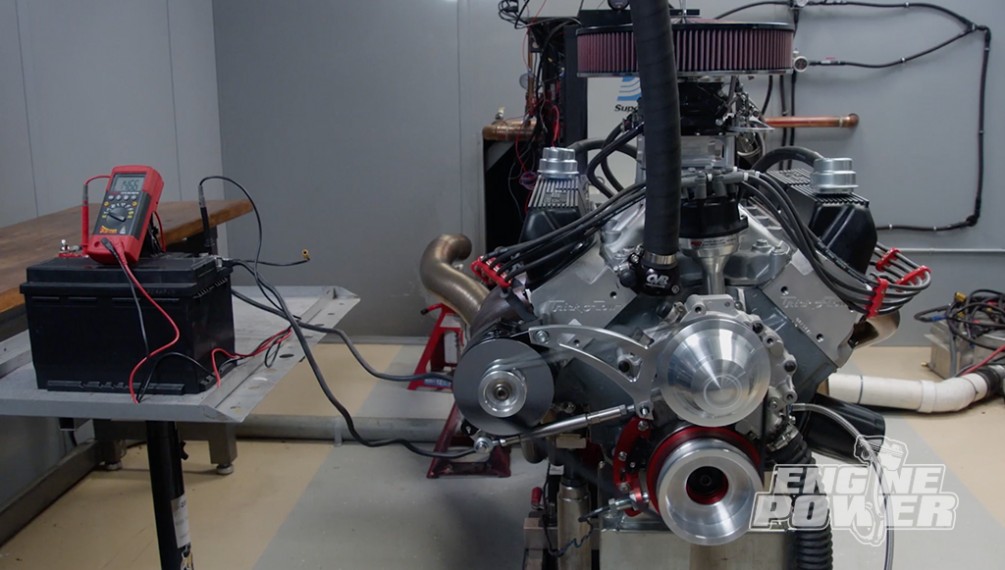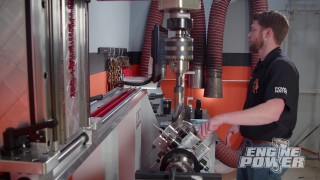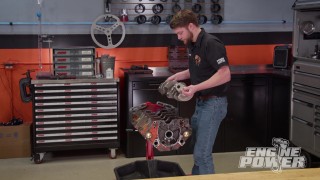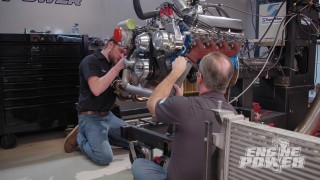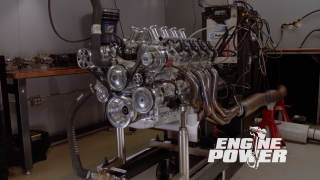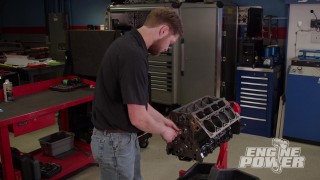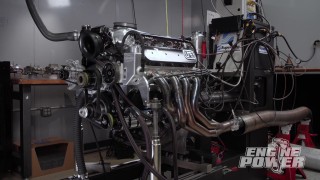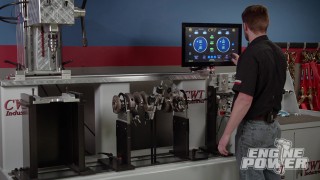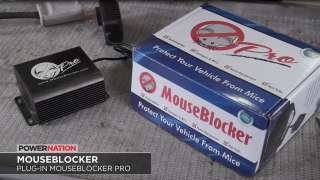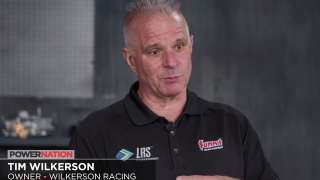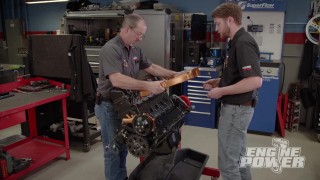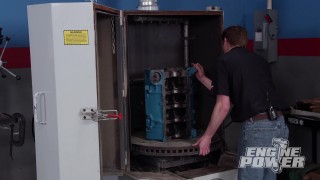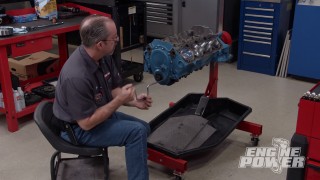Engine Power Featured Projects
Engine Power Builds
Want more content like this?
Join the PowerNation Email NewsletterParts Used In This Episode
Matco Tools
MATCO Tools are the Official Tool Supplier to PowerNation
The Industrial Depot
Tools, Hardware, Shop Supplies
Episode Transcript
(Pat)>> You're watching Powernation!
(Frankie)>> Just because your engine can make big horsepower doesn't mean it will make big horsepower.
(Pat)>> Today on Engine Power we clear up some common myths and find out how to get some big power out of our 408 Windsor. [ MUSIC ] Welcome to Engine Power and another edition of our very popular back to basics series. Today we are going to go over a few engine myths on the dyno and maybe even dispel a couple of them in our ongoing quest to always find more horsepower.
(Frankie)>> And we're not going to do it on some clapped out 305. This time we have our 408 Windsor that makes over 600 horsepower. So the results should be very clear cut, and they might just surprise you.
(Pat)>> Here are the myths we are going over today. Myth one, cold versus hot lash settings. Myth two, air cleaner restriction. Myth three, accessories rob excessive horsepower, and myth four, header sizing. Our first myth is one we get a lot of comments on and is commonly confusing to some but in reality it's very simple. Cold versus hot lash settings. When you get a new solid lifter cam, whether it's either a flat tappet or a roller, it comes with a cam card with a lash setting but that lash setting is for the engine at operating temperature, hot lash. It is a common misconception that when the engine heats up some of that lash is taken up by the heat, but in fact it is the direct opposite. As engine temperature increases the clearance enlarge increasing measured lash.
(Frankie)>> Aluminum and cast iron expand at different rates, but there are general guidelines on how tight lash should be when cold in order to be correct at operating temperature. Now we do all this to make sure that the engine is in a safe range before initial startup and no parts are damaged. For cast iron blocks with cast iron heads lash should be set roughly four thousandths of an inch tighter. For cast iron blocks with aluminum heads lash is set roughly six thousandths of an inch smaller because the aluminum expands more, and for aluminum blocks with aluminum heads lash should be set between 8 and 12 thousandths tighter depending on the physical size of the engine. This particular engine has a hot lash setting of 16 thousandths for the intake and 18 thousandths for the exhaust. So after we subtract our six thousandths for our cast iron block and aluminum heads we get 10 thousandths for the intake and 12 thousandths for the exhaust for our cold setting.
(Pat)>> To demonstrate this we will adjust our rockers on this engine at ambient temperature to their cold lash setting. Then we will fire up the engine, get it up to operating temp, pull a valve cover, and then check the lash again to show you what the difference is. Now keep in mind to get an accurate valve lash setting at hot lash you have to check it at operating temp. We'll set cold lash at 10 thousandths on the intake and 12 thousandths on the exhaust. When using a feeler gauge you want to have some resistance when sliding it between the rocker and the valve, but not so much that it becomes difficult to get in there. Our engine is at room temperature at this point, 67.6 degrees. Alright ready for fuel? [ MUSIC ] Clear up front. [ engine starting ]
(Pat)>> After warming up the engine for several minutes to operating temp the valvetrain is now over 200 degrees Fahrenheit. [ MUSIC ] Now that we're up to temp we'll check our hot lash setting at 16 and 18. [ MUSIC ] 16! [ engine cranking ] [ MUSIC ]
(Pat)>> A tight 18. I'll give you a thousandth on that one. Just to compare we are going to stick our cold lash settings back in there and see if they are tighter or looser. Here's our cold setting, 10. [ MUSIC ] [ engine cranking ] 12! It's not even, a little on the loose side there. Now this is something you can absolutely check for yourself if you have something you can set lash on. Set your lash, heat it up, and recheck it while it's hot. You'll find out what the truth is.
(Frankie)>> Up next, when choosing a set of headers you often have to make compromises, but those compromises can kill some horsepower.
(Frankie)>> I'm here with Team Summit NHRA funny car driver Tim Wilkerson. Tim today's subject is all about bearings and depending on your application, whether it's a street or full blown race engine, the bearing construction's gonna be pretty different.
(Tim)>> Yeah Frank, you know street versus racing, materials are gonna be different. You're gonna have some coating difference. It's gonna be real evident in the cost of that bearing.
(Frankie)>> So let's talk about the difference in construction between a race and street engine.
(Tim)>> Well basically we'll start with the race engine since that's more up my alley. This racing bearing's going to be much more rigid. It's tougher and it works in a different environment than your street motor.
(Frankie)>> So it has to endure much harsher conditions. So it's gonna be a little bit more rigid is what you're saying.
(Tim)>> Sure and your stock bearing, it's living a long life isn't it? We're trying to get that thing to a couple of hundred thousand miles.
(Frankie)>> So Tim what's the benefit of a coated bearing like we have here?
(Tim)>> Well I think Frankie that's really evolved from cold start problems. That really helps the lubricity. Oil gets through there easier. All that's gonna work better.
(Frankie)>> Let's talk about installation and what important steps you have to take when you're trying to make your bearings last a long time.
(Tim)>> Well first it starts with your housing bore. You're gonna have a quality machine shop make your housing bore correct. You keep it good and clean. That makes that installation flawless.
(Frankie)>> So picking the right bearings and having everything sized properly and clean is really important when you're installing your bearings.
(Tim)>> Yep that's probably the key. You know Frankie the good thing about all that is the folks at Summit Racing, they offer a bearing for virtually every application street to race.
(Frankie)>> The next topic we're gonna discuss is header sizing. Now it's really normal when you're trying to package a new engine into your hot rod to make compromises with header size and length in order to get to fit, but since we have the luxury of a dyno we wanted to show you what header sizing actually does to horsepower numbers. So we have a few headers we're gonna try. We're starting with a one and five-eighths primary shorty header that's on our 408 now, and then we have a one and five-eighths primary long tube header, and then finally a two in primary long tube race header, and we're gonna show you how they affect power output.
(Pat)>> Alright this engine hasn't been on in a while. Last time it was on it made 600. Well in excess of 600. I can't remember what we've done to this carburetor. I think we might have leaned it out a little bit. So we're gonna go real easy on this pull and go 4,500 to 7,000 at 300 percent.
(Frankie)>> Easy yeah! [ engine revving ]
(Pat)>> It got a little crackley at the end here. Oh okay! Well this is kind of our baseline test right? 546.5 horsepower at 6,500, 487.9 pound feet of torque at 5,100.
(Frankie)>> Hopefully that is the headers like we kind of expected. We're gonna find out.
(Pat)>> Otherwise the engine's got some serious problems. Hey put on the set of long tube one and five-eighths.
(Frankie)>> See what that does. [ ratchet clicking ] [ engine revving ]
(Pat)>> It sounded better and I think it printed some better numbers too. 551 horse. Now much bigger on the power but look at the torque. 508.8 at 4,800, better everywhere. Really better down low. Not so great up top as far as a lot more but still cracked 500 for torque, which that's big. Before it was 487, now it is 508.8.
(Frankie)>> That's pretty commonly held that long tubes are better for low end torque.
(Pat)>> Better for torque I would agree with that. Now we didn't change primary size. So power is power. So going from the one and five-eighths inch long tube to a two inch tube race header, what do you think it's gonna do?
(Frankie)>> You'd think it would help but that's kinda why we're doing this test to find out.
(Pat)>> Yep. [ MUSIC ] [ engine revving ]
(Pat)>> Okay 589 horsepower, 516 pound feet of torque.
(Frankie)>> So 43 horse in headers, that's crazy. That's really cool though!
(Pat)>> That does show headers are a restriction when they're sized wrong. Again when you had the headers on before and it ran fine, the difference between 546 and 589, big on a dyno. On a car that you put it in and it burns the tire off I don't know if you'd even see that unless you're on a dragstrip and you dead hooked it with a slick.
(Frankie)>> Back to back testing.
(Pat)>> Now the question is why isn't it making 600? Well here's the thing. Last time we ran this engine one, there's no evacs on it right? We ran it with evacs before. We had an electric water pump on it, and it was razor tuned with that carburetor. Up next, on a high horsepower engine the choice of air cleaner can make a big difference in horsepower.
(Pat)>> Now we're gonna move on to our air cleaner test. If you remember we did this exact same test on our worn out 305 small block Chevy with some lackluster results all because the engine simply didn't make enough power or flow enough c-f-m to make a huge difference. We used an o-e-m style air cleaner, a hot rod style air cleaner with a small element, a lower profile 10 inch, and a 14 inch with a flow through top. Now this engine makes almost triple the power of that small block Chevy. So it's gonna be interesting to see what it does for power. Hopefully it'll be a little more dramatic, but there's only one way to find out. [ MUSIC ] [ engine revving ]
(Pat)>> It's really down on power! 509.4 horsepower, 80 horse!
(Frankie)>> Oh my gosh! I'm not super surprised but I did not think it was gonna be that much.
(Pat)>> Filtering air is important but not that important. The manifold vacuum literally went from 1.3, 1.4 wide open to 4.8. It's like shoving a shop rag in the air cleaner. Now the hot rod, T-bucket slash little tiny air filter element one. Let's try that one next. [ engine revving ]
(Frankie)>> Oh yeah!
(Pat)>> Now we're back up to 551.7, 503.9 at 5,100. Definitely better!
(Frankie)>> Manifold vacuum's not way back down but down.
(Pat)>> It went from 4.8 to 2.8, 2.7, somewhere in there. Definitely an improvement. It goes to show that the higher the horsepower the more of an effect the restriction will be. It's getting better. Now we're going from the absolute worst to hopefully the best. Next one will be that 10 inch air cleaner. Dyno days are the best days.
(Frankie)>> This one's a little bit bigger but it's also a little bit shorter I think. So I don't know.
(Pat)>> This is the beauty of this. We have this spectacular test equipment so we can learn all this stuff. Here we go! [ engine revving ]
(Pat)>> How about them apples. 571.6, 6,500 and 511.2, 5,000. Now what we didn't do on the last one was the closed top versus the flow through top.
(Frankie)>> Which I really want to do that. You know what it's supposed to do but I've never actually got to try it and I want to see does it actually matter?
(Pat)>> On this one we're gonna find out because let's put that 14 inch element on there with that chrome top and see what it does. [ engine revving ]
(Pat)>> Made 581 at 6,000, peak torque 514 at 5,000.
(Frankie)>> Manifold vacuum's back down to 1.3.
(Pat)>> Manifold vacuum's down to something that's kinda normal. That's exactly what should happen. It'll be interesting when we compare everything to see where everything ends up right? Alright go put that open top on there.
(Frankie)>> I want to try this. I've been waiting a long time to try this.
(Pat)>> See what the flow through top does. [ engine revving ]
(Pat)>> Oh it is a little bit better. 586, 6,500.
(Frankie)>> Interesting cause the peak manifold vacuum is pretty close but overall I think on average it's lower.
(Pat)>> Just nice to show people what actually happens when you increase the c-f-m with an air cleaner assembly, or what happens when you decrease.
(Frankie)>> Whether you spent countless hours building your dream hot rod or you just dropped a pretty penny on a brand new toy the last thing you want are a bunch of critters chewing on it while it's parked. Mouse block has created multiple solutions to keep vermin from causing damage to your ride. Their units release an ultra-high frequency noise to deter rodents from nesting, and are great for any vehicle you need to protect. This is their plug in version of the mouse block pro. It can be plugged into any 115 volt outlet or extension cord, making it perfect for long term storage or places without 12 volt power like garages, sheds, and r/v's. It is 15 times louder than any other unit on the market and has three volume settings up to 115 decibels. It even has switchable l-e-d lights that strobe as an extra deterrent. Mouse Blocker devices are trusted by shops and dealers across the country and are available at Mouse Blocker dot com. Up next, just how much power do engine accessories rob? We're gonna find out!
(Frankie)>> The next top we're going to discuss is whether or not accessories rob excessive amounts of horsepower. Now we know they take some because they create resistance, but since we have a dyno we'll be able to measure that difference even if it's a small amount. This entire time we've running a mechanical water pump and we've had an alternator that's not hooked up using it simply as a tensioner, but now we're gonna wire it up.
(Pat)>> We are hooking everything up to charge this dead battery, and that will create amp load on the alternator and we will be able to measure the difference, if any, on our power output.
(Frankie)>> After that we'll take the mechanical water pump and alternator off and put this electric water pump in their place and see the difference.
(Pat)>> So we're gonna charge the battery and make a pull to see if the charging affects power. Alright we're charging, 14-67ish. [ engine revving ]
(Pat)>> Basically it made the same within one horse everywhere. That's not bad at all.
(Frankie)>> I thought it was gonna be more. I thought it was gonna be worth at a couple of horse.
(Pat)>> It is charging. Now the big test is with all that stuff off and an electric water pump on it so it's not driving anything. [ MUSIC ] [ engine revving ]
(Pat)>> We're gonna see. I thought I saw something cool. Yep 597.3, 520. I guess I'd believe that, and it picked up a little bit of torque, like two or three pound feet of torque. I would believe that. So this was a 600 horse engine when we started. We hadn't run it like before because it had the water pump on, it had the alternator on it. We are running different gasoline this time, and again that's a big factor. It's a different time of year. There's a whole bunch of different conditions that the engine was not in now that it's in. On a 600 horse engine we weren't doing it because we're trying to make a number. We were doing it to compare what happens when you change these components.
(Frankie)>> That's a pretty big change, and it probably would have been a little different. Our ratio before for our water pump was around one to one, and it'll make different ratios on overdrive.
(Pat)>> You can underdrive the pump. It takes a little bit less drag to run it.
(Frankie)>> Not something you would feel but for numbers a decent jump.
(Pat)>> Not something you would feel on the street but obviously that would show up if you had your car dialed in right on a dragstrip or a track. On a scientific test where we have the correct equipment to do it and we have a controlled test condition we can actually show results. This was a lot of fun.
(Frankie)>> I like these because I've never gotten to do anything like this before. Never had a dyno to play. You kinda did in racing and stuff but I'm not as old as you. I've never had this experience.
(Pat)>> I literally have hunting boots older than you. The big thing with engines is eliminating friction cause that frees up horsepower. It doesn't make horsepower, it frees up horsepower. And so there's a lot of things in the racing world that we've done to eliminate friction and eliminate pumping losses. So those are two things that we are going to go over in the future. Nice job! So what did we learn today? Despite the popular misconception valve clearance does not decrease as the engine reaches operating temperature it increases. Keep this in mind when setting either hot or cold lash.
(Frankie)>> Second header selection can make a massive change to your engine's output. If the headers are undersized or too short they can rob a bunch of horsepower. Going from one and five-eighths shorty headers to two inch long tube race headers gave us 42.5 more horsepower and 28.8 more pound feet of torque.
(Pat)>> On a lower output engine that doesn't require a lot of air your choice of air cleaner probably won't change the power numbers a lot, but on a higher output engine like our 408 Windsor it matters. Swapping out the o-e-m style unit with a 14 inch flow through top air cleaner netted us 76.9 more horsepower and 23.3 more pound feet of torque.
(Frankie)>> Assuming they are in good working order, engine accessories can rob some but not a lot of power. Even when charging a battery at over 14 volts the alternator had almost no effect on engine output. The water pump mad e a noticeable difference. Running a mechanical water pump off the accessory belt we saw an 11 horsepower decrease compared to the electric water pump we ran later.
(Pat)>> These are some easy things to remember when choosing parts for your next engine project, and for more information on anything you've seen today visit Powernation TV dot com.
Show Full Transcript
(Frankie)>> Just because your engine can make big horsepower doesn't mean it will make big horsepower.
(Pat)>> Today on Engine Power we clear up some common myths and find out how to get some big power out of our 408 Windsor. [ MUSIC ] Welcome to Engine Power and another edition of our very popular back to basics series. Today we are going to go over a few engine myths on the dyno and maybe even dispel a couple of them in our ongoing quest to always find more horsepower.
(Frankie)>> And we're not going to do it on some clapped out 305. This time we have our 408 Windsor that makes over 600 horsepower. So the results should be very clear cut, and they might just surprise you.
(Pat)>> Here are the myths we are going over today. Myth one, cold versus hot lash settings. Myth two, air cleaner restriction. Myth three, accessories rob excessive horsepower, and myth four, header sizing. Our first myth is one we get a lot of comments on and is commonly confusing to some but in reality it's very simple. Cold versus hot lash settings. When you get a new solid lifter cam, whether it's either a flat tappet or a roller, it comes with a cam card with a lash setting but that lash setting is for the engine at operating temperature, hot lash. It is a common misconception that when the engine heats up some of that lash is taken up by the heat, but in fact it is the direct opposite. As engine temperature increases the clearance enlarge increasing measured lash.
(Frankie)>> Aluminum and cast iron expand at different rates, but there are general guidelines on how tight lash should be when cold in order to be correct at operating temperature. Now we do all this to make sure that the engine is in a safe range before initial startup and no parts are damaged. For cast iron blocks with cast iron heads lash should be set roughly four thousandths of an inch tighter. For cast iron blocks with aluminum heads lash is set roughly six thousandths of an inch smaller because the aluminum expands more, and for aluminum blocks with aluminum heads lash should be set between 8 and 12 thousandths tighter depending on the physical size of the engine. This particular engine has a hot lash setting of 16 thousandths for the intake and 18 thousandths for the exhaust. So after we subtract our six thousandths for our cast iron block and aluminum heads we get 10 thousandths for the intake and 12 thousandths for the exhaust for our cold setting.
(Pat)>> To demonstrate this we will adjust our rockers on this engine at ambient temperature to their cold lash setting. Then we will fire up the engine, get it up to operating temp, pull a valve cover, and then check the lash again to show you what the difference is. Now keep in mind to get an accurate valve lash setting at hot lash you have to check it at operating temp. We'll set cold lash at 10 thousandths on the intake and 12 thousandths on the exhaust. When using a feeler gauge you want to have some resistance when sliding it between the rocker and the valve, but not so much that it becomes difficult to get in there. Our engine is at room temperature at this point, 67.6 degrees. Alright ready for fuel? [ MUSIC ] Clear up front. [ engine starting ]
(Pat)>> After warming up the engine for several minutes to operating temp the valvetrain is now over 200 degrees Fahrenheit. [ MUSIC ] Now that we're up to temp we'll check our hot lash setting at 16 and 18. [ MUSIC ] 16! [ engine cranking ] [ MUSIC ]
(Pat)>> A tight 18. I'll give you a thousandth on that one. Just to compare we are going to stick our cold lash settings back in there and see if they are tighter or looser. Here's our cold setting, 10. [ MUSIC ] [ engine cranking ] 12! It's not even, a little on the loose side there. Now this is something you can absolutely check for yourself if you have something you can set lash on. Set your lash, heat it up, and recheck it while it's hot. You'll find out what the truth is.
(Frankie)>> Up next, when choosing a set of headers you often have to make compromises, but those compromises can kill some horsepower.
(Frankie)>> I'm here with Team Summit NHRA funny car driver Tim Wilkerson. Tim today's subject is all about bearings and depending on your application, whether it's a street or full blown race engine, the bearing construction's gonna be pretty different.
(Tim)>> Yeah Frank, you know street versus racing, materials are gonna be different. You're gonna have some coating difference. It's gonna be real evident in the cost of that bearing.
(Frankie)>> So let's talk about the difference in construction between a race and street engine.
(Tim)>> Well basically we'll start with the race engine since that's more up my alley. This racing bearing's going to be much more rigid. It's tougher and it works in a different environment than your street motor.
(Frankie)>> So it has to endure much harsher conditions. So it's gonna be a little bit more rigid is what you're saying.
(Tim)>> Sure and your stock bearing, it's living a long life isn't it? We're trying to get that thing to a couple of hundred thousand miles.
(Frankie)>> So Tim what's the benefit of a coated bearing like we have here?
(Tim)>> Well I think Frankie that's really evolved from cold start problems. That really helps the lubricity. Oil gets through there easier. All that's gonna work better.
(Frankie)>> Let's talk about installation and what important steps you have to take when you're trying to make your bearings last a long time.
(Tim)>> Well first it starts with your housing bore. You're gonna have a quality machine shop make your housing bore correct. You keep it good and clean. That makes that installation flawless.
(Frankie)>> So picking the right bearings and having everything sized properly and clean is really important when you're installing your bearings.
(Tim)>> Yep that's probably the key. You know Frankie the good thing about all that is the folks at Summit Racing, they offer a bearing for virtually every application street to race.
(Frankie)>> The next topic we're gonna discuss is header sizing. Now it's really normal when you're trying to package a new engine into your hot rod to make compromises with header size and length in order to get to fit, but since we have the luxury of a dyno we wanted to show you what header sizing actually does to horsepower numbers. So we have a few headers we're gonna try. We're starting with a one and five-eighths primary shorty header that's on our 408 now, and then we have a one and five-eighths primary long tube header, and then finally a two in primary long tube race header, and we're gonna show you how they affect power output.
(Pat)>> Alright this engine hasn't been on in a while. Last time it was on it made 600. Well in excess of 600. I can't remember what we've done to this carburetor. I think we might have leaned it out a little bit. So we're gonna go real easy on this pull and go 4,500 to 7,000 at 300 percent.
(Frankie)>> Easy yeah! [ engine revving ]
(Pat)>> It got a little crackley at the end here. Oh okay! Well this is kind of our baseline test right? 546.5 horsepower at 6,500, 487.9 pound feet of torque at 5,100.
(Frankie)>> Hopefully that is the headers like we kind of expected. We're gonna find out.
(Pat)>> Otherwise the engine's got some serious problems. Hey put on the set of long tube one and five-eighths.
(Frankie)>> See what that does. [ ratchet clicking ] [ engine revving ]
(Pat)>> It sounded better and I think it printed some better numbers too. 551 horse. Now much bigger on the power but look at the torque. 508.8 at 4,800, better everywhere. Really better down low. Not so great up top as far as a lot more but still cracked 500 for torque, which that's big. Before it was 487, now it is 508.8.
(Frankie)>> That's pretty commonly held that long tubes are better for low end torque.
(Pat)>> Better for torque I would agree with that. Now we didn't change primary size. So power is power. So going from the one and five-eighths inch long tube to a two inch tube race header, what do you think it's gonna do?
(Frankie)>> You'd think it would help but that's kinda why we're doing this test to find out.
(Pat)>> Yep. [ MUSIC ] [ engine revving ]
(Pat)>> Okay 589 horsepower, 516 pound feet of torque.
(Frankie)>> So 43 horse in headers, that's crazy. That's really cool though!
(Pat)>> That does show headers are a restriction when they're sized wrong. Again when you had the headers on before and it ran fine, the difference between 546 and 589, big on a dyno. On a car that you put it in and it burns the tire off I don't know if you'd even see that unless you're on a dragstrip and you dead hooked it with a slick.
(Frankie)>> Back to back testing.
(Pat)>> Now the question is why isn't it making 600? Well here's the thing. Last time we ran this engine one, there's no evacs on it right? We ran it with evacs before. We had an electric water pump on it, and it was razor tuned with that carburetor. Up next, on a high horsepower engine the choice of air cleaner can make a big difference in horsepower.
(Pat)>> Now we're gonna move on to our air cleaner test. If you remember we did this exact same test on our worn out 305 small block Chevy with some lackluster results all because the engine simply didn't make enough power or flow enough c-f-m to make a huge difference. We used an o-e-m style air cleaner, a hot rod style air cleaner with a small element, a lower profile 10 inch, and a 14 inch with a flow through top. Now this engine makes almost triple the power of that small block Chevy. So it's gonna be interesting to see what it does for power. Hopefully it'll be a little more dramatic, but there's only one way to find out. [ MUSIC ] [ engine revving ]
(Pat)>> It's really down on power! 509.4 horsepower, 80 horse!
(Frankie)>> Oh my gosh! I'm not super surprised but I did not think it was gonna be that much.
(Pat)>> Filtering air is important but not that important. The manifold vacuum literally went from 1.3, 1.4 wide open to 4.8. It's like shoving a shop rag in the air cleaner. Now the hot rod, T-bucket slash little tiny air filter element one. Let's try that one next. [ engine revving ]
(Frankie)>> Oh yeah!
(Pat)>> Now we're back up to 551.7, 503.9 at 5,100. Definitely better!
(Frankie)>> Manifold vacuum's not way back down but down.
(Pat)>> It went from 4.8 to 2.8, 2.7, somewhere in there. Definitely an improvement. It goes to show that the higher the horsepower the more of an effect the restriction will be. It's getting better. Now we're going from the absolute worst to hopefully the best. Next one will be that 10 inch air cleaner. Dyno days are the best days.
(Frankie)>> This one's a little bit bigger but it's also a little bit shorter I think. So I don't know.
(Pat)>> This is the beauty of this. We have this spectacular test equipment so we can learn all this stuff. Here we go! [ engine revving ]
(Pat)>> How about them apples. 571.6, 6,500 and 511.2, 5,000. Now what we didn't do on the last one was the closed top versus the flow through top.
(Frankie)>> Which I really want to do that. You know what it's supposed to do but I've never actually got to try it and I want to see does it actually matter?
(Pat)>> On this one we're gonna find out because let's put that 14 inch element on there with that chrome top and see what it does. [ engine revving ]
(Pat)>> Made 581 at 6,000, peak torque 514 at 5,000.
(Frankie)>> Manifold vacuum's back down to 1.3.
(Pat)>> Manifold vacuum's down to something that's kinda normal. That's exactly what should happen. It'll be interesting when we compare everything to see where everything ends up right? Alright go put that open top on there.
(Frankie)>> I want to try this. I've been waiting a long time to try this.
(Pat)>> See what the flow through top does. [ engine revving ]
(Pat)>> Oh it is a little bit better. 586, 6,500.
(Frankie)>> Interesting cause the peak manifold vacuum is pretty close but overall I think on average it's lower.
(Pat)>> Just nice to show people what actually happens when you increase the c-f-m with an air cleaner assembly, or what happens when you decrease.
(Frankie)>> Whether you spent countless hours building your dream hot rod or you just dropped a pretty penny on a brand new toy the last thing you want are a bunch of critters chewing on it while it's parked. Mouse block has created multiple solutions to keep vermin from causing damage to your ride. Their units release an ultra-high frequency noise to deter rodents from nesting, and are great for any vehicle you need to protect. This is their plug in version of the mouse block pro. It can be plugged into any 115 volt outlet or extension cord, making it perfect for long term storage or places without 12 volt power like garages, sheds, and r/v's. It is 15 times louder than any other unit on the market and has three volume settings up to 115 decibels. It even has switchable l-e-d lights that strobe as an extra deterrent. Mouse Blocker devices are trusted by shops and dealers across the country and are available at Mouse Blocker dot com. Up next, just how much power do engine accessories rob? We're gonna find out!
(Frankie)>> The next top we're going to discuss is whether or not accessories rob excessive amounts of horsepower. Now we know they take some because they create resistance, but since we have a dyno we'll be able to measure that difference even if it's a small amount. This entire time we've running a mechanical water pump and we've had an alternator that's not hooked up using it simply as a tensioner, but now we're gonna wire it up.
(Pat)>> We are hooking everything up to charge this dead battery, and that will create amp load on the alternator and we will be able to measure the difference, if any, on our power output.
(Frankie)>> After that we'll take the mechanical water pump and alternator off and put this electric water pump in their place and see the difference.
(Pat)>> So we're gonna charge the battery and make a pull to see if the charging affects power. Alright we're charging, 14-67ish. [ engine revving ]
(Pat)>> Basically it made the same within one horse everywhere. That's not bad at all.
(Frankie)>> I thought it was gonna be more. I thought it was gonna be worth at a couple of horse.
(Pat)>> It is charging. Now the big test is with all that stuff off and an electric water pump on it so it's not driving anything. [ MUSIC ] [ engine revving ]
(Pat)>> We're gonna see. I thought I saw something cool. Yep 597.3, 520. I guess I'd believe that, and it picked up a little bit of torque, like two or three pound feet of torque. I would believe that. So this was a 600 horse engine when we started. We hadn't run it like before because it had the water pump on, it had the alternator on it. We are running different gasoline this time, and again that's a big factor. It's a different time of year. There's a whole bunch of different conditions that the engine was not in now that it's in. On a 600 horse engine we weren't doing it because we're trying to make a number. We were doing it to compare what happens when you change these components.
(Frankie)>> That's a pretty big change, and it probably would have been a little different. Our ratio before for our water pump was around one to one, and it'll make different ratios on overdrive.
(Pat)>> You can underdrive the pump. It takes a little bit less drag to run it.
(Frankie)>> Not something you would feel but for numbers a decent jump.
(Pat)>> Not something you would feel on the street but obviously that would show up if you had your car dialed in right on a dragstrip or a track. On a scientific test where we have the correct equipment to do it and we have a controlled test condition we can actually show results. This was a lot of fun.
(Frankie)>> I like these because I've never gotten to do anything like this before. Never had a dyno to play. You kinda did in racing and stuff but I'm not as old as you. I've never had this experience.
(Pat)>> I literally have hunting boots older than you. The big thing with engines is eliminating friction cause that frees up horsepower. It doesn't make horsepower, it frees up horsepower. And so there's a lot of things in the racing world that we've done to eliminate friction and eliminate pumping losses. So those are two things that we are going to go over in the future. Nice job! So what did we learn today? Despite the popular misconception valve clearance does not decrease as the engine reaches operating temperature it increases. Keep this in mind when setting either hot or cold lash.
(Frankie)>> Second header selection can make a massive change to your engine's output. If the headers are undersized or too short they can rob a bunch of horsepower. Going from one and five-eighths shorty headers to two inch long tube race headers gave us 42.5 more horsepower and 28.8 more pound feet of torque.
(Pat)>> On a lower output engine that doesn't require a lot of air your choice of air cleaner probably won't change the power numbers a lot, but on a higher output engine like our 408 Windsor it matters. Swapping out the o-e-m style unit with a 14 inch flow through top air cleaner netted us 76.9 more horsepower and 23.3 more pound feet of torque.
(Frankie)>> Assuming they are in good working order, engine accessories can rob some but not a lot of power. Even when charging a battery at over 14 volts the alternator had almost no effect on engine output. The water pump mad e a noticeable difference. Running a mechanical water pump off the accessory belt we saw an 11 horsepower decrease compared to the electric water pump we ran later.
(Pat)>> These are some easy things to remember when choosing parts for your next engine project, and for more information on anything you've seen today visit Powernation TV dot com.
